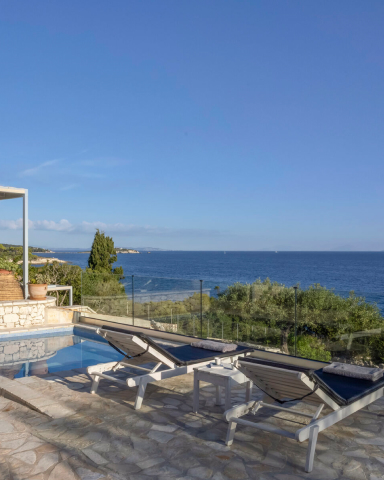Mouthwatering traditional Greek and Ionian recipes

Greek and Ionian Island cuisine is based on fresh local ingredients prepared in traditional ways, following recipes and techniques that have been passed down over generations. Ordering (or cooking!) a meze (lots of little dishes) will give you a chance to try a variety of mouthwatering specialities in one sitting, though you may be equally tempted by our seafood recipes, including octopus, swordfish and that old favourite, calamari. Then again, Greek meat dishes are also to die for... why not try them all!Here are some traditional Greek foods and recipes for you to sample.
Starters and meze dishes
Grilled halloumi with aromatic, herb-infused olive oil
Ingredients
For the halloumi
150g halloumi cut into 2cm-thick slices
Extra virgin olive oil
For the herb-infused olive oil
1 small handful of parsley, finely chopped
1 small handful coriander, finely chopped
1 small handful mint, finely chopped
1 clove garlic, minced1 anchovy fillet, chopped
Extra virgin olive oil
Juice of half a lemon
Salt and pepper
Method
First, at least an hour before you sit down for dinner, make the herb-infused olive oil - it gets tastier the longer it’s rested, so you could even make it in the morning.
Finely chop the herbs, garlic and anchovy fillet (you could do this in a blender if you prefer) and place in a bowl. Add a glug of olive oil and mix so that you have a homogenous, slightly loose sauce similar in consistency to pesto. Squeeze in the lemon (about half the quantity of the oil), season with a little salt and black pepper, and mix well. Leave to infuse, mixing and tasting occasionally (you might wish to adjust the seasoning or add more lemon for a little extra zing).
Slice the halloumi into 1.5/2cm-thick slices. Brush lightly with olive oil and place in a hot frying pan. Leave for a minute and flip. Both sides should have a nice golden-brown colour.
Serve with good spoonful of the herb-infused oil.
Tzatziki
Ingredients (serves 2-4)
250ml Greek yoghurt
2 cloves garlic (or 1 if you want to keep it a bit tamer!)
Half a cucumber
Salt and pepper
Olive oil
1/2 tsp vinegar
A little parsley
A couple of soft black olives
Method
Put the yoghurt in a bowl. Crush the garlic cloves and add to the yoghurt. Grate the cucumber (don’t peel) and squeeze the liquid out before adding to the yoghurt. Add some olive oil, a little vinegar and pepper to taste and mix all ingredients well. Sprinkle some fresh parsley and top with a couple of olives. Serve with pitta or crusty bread to dip.
Recipe courtesy of our friends at the Kollokas Taverna, Katouna
Grilled feta
Ingredients (serves 2-4)
200gr hard feta, sliced
A couple of slices of tomato
A couple of slices of green pepper
Olive oil
Black pepper
Method
Place the slices of feta on one layer on some aluminium foil, making sure the sides of the foil are big enough to cover the feta. Layer the tomato and pepper slices on top and pour over some olive oil. Finish off with some black pepper and fold the aluminium foil over the top, closing the package. Place in a hot oven (180°C), or under the grill, for about 5 minutes until cheese is soft. Serve with crusty bread.

Grilled Halloumi
Main courses
Dakos
Dakos is a traditional Cretan recipe, not dissimilar to Italian bruschetta. It's a refreshing and extremely tasty dish that's perfect for a light summer lunch.
The recipe below is reproduced with the kind permission of Vori, a Greek restaurant in Holland Park, London. If you find it difficult to source any of the ingredients specified below, just head to our friends at Maltby&Greek, purveyors of the very best gastronomic delights that Greece has to offer. Until the end of September 2020, you can get a 15% discount on your online shop. Just apply the discount code TTT at check-out.
Ingredients
50g Cretan barley rusks (if you get your hands on the small ones, otherwise a large one would do as well)
50g mizithra cheese - Cretan preferably, but all parts of Greece have unique versions of mizithra that work well with dakos
2-4 organic vine tomatoes (depending on size). You can always be liberal with tomatoes!
10g Santorini capers
Pinch kithira sea salt
Extra virgin olive oil
1/2 teaspoon organic oregano
Method
1. Wash the tomatoes well, and grate them, removing all the liquids.
2. Moisten your barley rusks. Consistency varies among rusks, so some just need a quick sprinkle of water, others a healthier dose. The objective is to dampen them, not soak them.
3. Sprinkle your Greek olive oil generously over the rusk, and let it absorb it - the taste of olive oil in the rusk is sublime!
4. Add the grated tomato - the juices will get absorbed by the rusk giving that extra depth of flavour to the dish.
5. Top the rusk with the mizithra cheese and capers.
6. Sprinkle with salt.
7. Drizzle everything for one last time with that lovely extra virgin olive oil.8. Lastly sprinkle the oregano on top of your dakos.
8. Tuck in, and enjoy your own slice of Greece!
Gemista - stuffed tomatoes, peppers and aubergines
Method
Pre-heat the oven to 180°C. Cut the top off the tomatoes and the peppers (keep the tops) and halve the aubergines lengthways. Clean out the peppers, scoop out the inside of the tomatoes and the aubergines and chop the pulp of these last two finely. Add this mixture to the rice, chopped onion, garlic, parsley and mint. Season with pepper and salt and some olive oil.
Put the tomatoes, peppers and aubergines side by side in a lightly oiled ovenproof dish. Fill them with the mixture and put the tops back on the tomatoes and peppers. Peel and quarter the potatoes and place around the vegetables. Mix the tomato purée with the water and pour in the dish. Place in a medium oven for about 1½ hours.
Recipe courtesy of our friends at the Seven Islands Taverna, Lygia
Moussaka
Ingredients (serves 4)
2 aubergines
400gr potatoes
500gr beef mince
1 onion
2 cloves of garlic
Some fresh parsley, chopped
½ tsp ground cloves
250gr tinned tomatoes
Handful of breadcrumbs
Extra virgin olive oil
Salt and pepper
For the white sauce:500ml milk60gr butter60gr flour2 eggs, beaten½ tsp grated nutmegPecorino, grated
Method
Preheat the oven to 180°C. Cut the aubergines and potatoes lengthways into slices and fry with some olive oil. In a separate pan, brown the mince with the onion, garlic, parsley and cloves and then add the tomatoes. Season to taste with salt and pepper
.To make the white sauce, bring the milk to just below boiling point. Melt the butter in another saucepan then stir the flour into the butter and gradually whisk in the hot milk. Cook until you have a thick sauce. Take off the heat and allow to cool slightly before beating in the eggs and nutmeg. Add salt to taste.
Place a layer of breadcrumbs in the bottom of an ovenproof dish. Layer with the potatoes and the aubergines (the breadcrumbs help soak up some of the oil of the aubergines). Spoon the mince mixture over it and top with the white sauce. Sprinkle with the grated cheese and bake for about 45 minutes until well browned.
Recipe courtesy of our friends at the Seven Islands Taverna, Lygia.
Astakomakaronada (lobster pasta, Alonissos-style)
Ingredients
2 lobster tails, shell-on (if frozen, make sure they are fully defrosted before cooking)
Half an onion, chopped finely
Quarter of a fennel bulb, sliced finely (and keep some fronds for the garnish)
2 cloves garlic, finely chopped
1 small tin chopped tomatoes
1 tbsp Greek brandy
1 glass water
Extra virgin olive oil
A pinch of chilli flakes
A pinch of fresh or dried thyme
Salt and pepper
180g spaghetti
Method
First, chop the onion and the fennel finely and sauté gently in a large frying pan until soft and translucent. Add the garlic and the chilli and cook for another minute.
Add the lobster tails and cook on a lively heat for a couple of minutes, turning every 30 seconds or so. Then pour in the brandy and flambé (if you feel confident to do so). When the flame has gone out (or after the alcohol has evaporated if you're not flambéing it), add the water, season with a pinch of salt and black pepper, cover, and cook for about seven or eight minutes until the lobster flesh has just gone white and opaque.
Remove the lobster from the pan and keep in a warm place. Then add the tomatoes and the thyme to the pan, mix well, and simmer on a lively flame, reducing the liquid to a thickish, homogeneous sauce (remember to taste it for seasoning). In the meantime, cook the spaghetti in a pan of salted boiling water.
Drain the spaghetti when al dente (keeping a few spoons of the water to one side), and plunge into the sauce. Toss with a little of the pasta water until the spaghetti is fully coated.
Serve the spaghetti, position a lobster tail on top of each portion and garnish with fennel fronds.

Astakomakaronada
Desserts
Baklava
Ingredients
For the baklava
200g unsalted butter, melted
150g walnuts
50g almond flakes
50g pistachios (unsalted)
2tsps ground cinnamon
2x270g packets of filo pastry
For the syrup
300ml water
300g caster sugar
100ml Greek honey
1 cinnamon stick
3 or 4 cloves
2 cardamom pods
Tips before you start
1. Take the filo pastry out of the fridge about 20 minutes before you need to use it so that it comes up to near room temperature. While assembling the baklava, keep the filo moist with a clean, slightly damp tea towel (if you feel that it’s drying out).
2. Don’t blitz the nuts too finely. You want a course mixture with pieces the size of peppercorns or a little larger.
3. Make sure that the syrup is hot when you pour it on the baklava.
4. Check how many slices of filo pastry are in your packet. As a general rule of thumb, you need more layers on the bottom and the top than in the middle.
5. Keep an eye on the baklava when it’s in the oven. It should take about 30 minutes, but you might need a little more or a little less. Just make sure it doesn’t burn. The end product should be burnished golden-brown in colour.
6. Baklava should be rested for several hours (or even a day) before eating.
7. The above ingredients will make a good batch of baklava, which should keep you going for a few days.
Method
Pre-heat your over to 180°C (350°F/gas mark 4), melt the butter gently, and start preparing the baklava.
Put all the nuts and the ground cinnamon in a food processor and pulse a few times until you have a coarse mixture.
Take a baking tin of approx. 13x9 inches (33cm x 23cm) and brush the bottom and sides with melted butter. Place your first layer of filo pastry into the backing tin and brush with butter. Repeat with 4 or 5 more layers (making sure you have plenty left for the middle and the top). Sprinkle in about half of your nut mixture in an even layer, and then cover with 2 or 3 more pieces of filo pastry, brushing each one with butter. Then add the remainder of the nut mixture (apart from a spoonful, which can be kept back for presentation purposes) and cover with the remaining layers of filo pastry (buttering each one).
Once you’ve assembled the baklava, it’s time to create individual portions. To do this, take a sharp knife and cut into thirds, lengthwise, making sure not to cut all the way to the bottom. Then cut on the diagonal (around 45°), so that you have diamond shapes.
Place the baklava in the middle of the oven for about 30-35 minutes, checking occasionally to make sure that it doesn’t burn or brown to quickly. You’ll know it’s ready when you see a lovely burnished gold colour on top. When ready, take out and leave to cool on the top.
While the baklava is cooking, make the syrup: mix the ingredients into a saucepan and heat, stirring occasionally, until the liquid comes a gentle boil. Leave it simmer for about 10 minutes and then turn down and keep hot.
When the baklava has cooled, pour the hot syrup over it evenly. If you feel you have too much syrup, just use what you think is enough – you can always add a little more later (re-heated). Sprinkle with the remaining nut mixture on top.
To serve, cut along the lines you've already created, but this time going through the bottom layer. You should hear an appetising crunch and crackle.
Galaktoboureko
(Custard pie)
Ingredients (serves 4)
For the filling
1.25 litres milk
1 cup semolina
1 tbsp vanilla extract
5 eggs
1 cup sugar
1 tbsp unsalted butter
For the syrup
3 cups sugar
2 cups water
Peel of 1 lemon
1 cinnamon stick
450gr filo pastry sheets
230gr unsalted butter, melted for brushing
Method
Preheat the oven to 180°C (350°F) degrees.
Heat the milk with the sugar and the vanilla extract until just boiling. Lower the heat and add the semolina. Stir constantly for 5 minutes until the cream starts to thicken and remove from the heat. Beat the eggs and add little by little to the cream. Add the butter and set aside to cool down.
Brush the bottom and sides of a medium rectangular pan (about 9 x 12). Layer half of the pastry sheets one by one in the bottom of the pan and brush each sheet with melted butter. Add the custard on top of the sheets and layer the rest of the pastry sheets on top of the custard layer, brushing each sheet with melted butter. Sprinkle a little bit of water on the top. Bake in a preheated oven for about 40 minutes until the filo turns a deep golden colour.
The syrup:
Boil the water with the sugar, lemon peel and cinnamon stick for approximately 10 minutes. Remove the peel and cinnamon and set aside.
When the syrup and custard are at room temperature, ladle the syrup carefully over the cool custard and allow time for it to be absorbed.
Recipe courtesy of our friends at the Taverna Greco Levante, Athani

We're Villa Matchmakers
Because our local experts have personally visited each of our destinations, we know exactly what makes them special. Tell us what your ultimate villa holiday looks like, and allow us take care of the rest.




